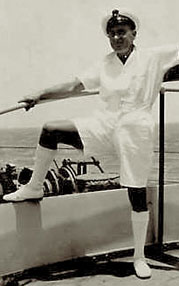CONTENTS
- Background: PQ17
- Biography: Jack Bowman
- HMS La Malouine
- Galleries:
- PQ17: Merchant Ships
- PQ17: Close Escort
PQ17 Diary
Jack Bowman

Engine Room Artificer (ERA) HMS La Malouine, 1940-44 (c) Bowman family archive.
Background | 2 of 3
PQ17 gathered, as had previous PQ convoys, at Hvalfjord in Iceland.
Admiral of the Fleet, Sir John Tovey wished to delay its sailing until sufficient escorts, including an aircraft carrier, were available to prevent similar losses to those incurred by PQ16. The presence of the Tirpitz also concerned him. He was convinced that that the Tirpitz battlegroup would sortie and that he required an escort capable of deterring such a fearsome opponent. Tovey was correct in his supposition for the Kriegsmarine had formulated the Knights Move (Rosselsprung), a plan to bring Tirpitz and her entourage into contact with the next outbound convoy - PQ17. It was this fear of Tirpitz which killed PQ17. Admiral of the Fleet, Sir Dudley Pound, with this fear in mind, indicated to Tovey that he would scatter PQ17 if German heavy units appeared. This flew in the face of all received wisdom about convoy management. It did not bode well for the future.
The assembled covering force was strong. In addition to the close covering force of destroyers and corvettes there were also four cruisers commanded by Rear-Admiral Louis Hamilton. Additionally, under the command of Tovey, a battlefleet including HMS Duke of York , USS Washington and HMS Victorious shadowed the convoy, well out of sight.
So, on 27 June 1942, Convoy PQ17 with its 35 merchantmen, sailed.
The convoy was sighted by a Focke-Wulf 200 (Condor) on 1st July, then again by U-255. The convoy escorts had detected the U-boat threat and had harried U-456 tenaciously during the day. The Germans took no action against the convoy. Then, on 2 July the Germans made their move, launching a torpedo bomber attack. The escorts managed to bring one Heinkel He115 down. The convoy escaped unscathed. On the evening of the 2nd the Tirpitz battlegroup was ordered to move from Trondheim to Altenfjord. Throughout the 3rd the convoy was harried by submarines but no losses were incurred.
Then the 4th of July dawned. It began with an air-launched torpedo attack which claimed the Christopher Newport. The Luftwaffe now planned a strong assault on the convoy, however their approach was detected and the convoy escort was able to close-up and intimidated the He115 bombers so much that they dropped their torpedoes out of range. In the meantime Royal Air Force (RAF) reconnaissance had discovered the absence of Tirpitz at Trondheim.
At just after 20.00hrs on 4 July the Germans attacked again with Junkers Ju88s and Heinkel He111s, in all some 25 aircraft. The attack was made on both flanks of the convoy. Unfortunately for those pilots attacking the port side the destroyer USS Wainwright had been refuelling from the convoy oiler Aldersdale. When her captain saw the attack developing he raced his ship at 32 knots towards the bombers. When 4000 yards from the convoy he swung broadsides to the attack. This brought his AA armament to bear. The attacking bombers were so off put that all torpedoes were dropped short. From starboard the attack continued, the aircraft flying into a wall of AA fire from the convoy and its escort. This time torpedoes were dropped within range and hits made to William Hooper, Navarino and the Russian tanker Azerbaijan. Only Azerbaijan recovered from her wounds to rejoin the convoy.
The convoy had been harried by U-boats all day and had driven off concerted attacks by the Luftwaffe. despite the losses the convoy was well protected and morale amongst merchantmen and warships alike was high. Commander Jack Broome, commander of the close escort, commented in his diary:
...provided the ammunition lasted, PQ17 could get anywhere.
| Background - continued ...